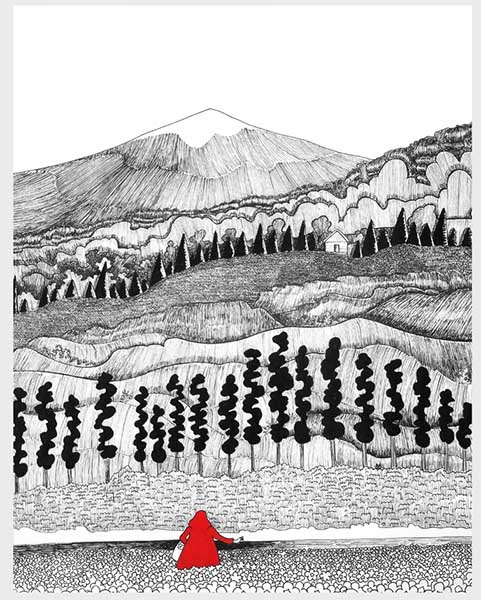
The story of Little Red Riding Hood is so old, no one really knows its origin. But a new version published this summer by the Anchorage Museum in Alaska recasts the familiar tale as a celebration of language, diversity and self-determination.
“Little Red Riding Hood: A New Translation” is the latest product of a three-year research project by Associate Professor of Art Marek Ranis into unique words in many languages that have no direct English translation. It is illustrated by alumna Hannah Barnhardt ’16.
Partnering with London-based psychology scholar Tim Lomas and the Anchorage Museum, Ranis launched a community-engaged art project in 2017 to expand Lomas’s “Positive Lexicography” index. Through an event at the museum, where Ranis is curator at large, and subsequent interviews with taxicab drivers, Ranis collected new vocabulary. That research led to a card game, “TAXI: The Cross-Cultural Word Game,” and the Cafuné Project: Dancing Nuances of Culture, which incorporated dance, film, improvisation, live music and language.
“Little Red Riding Hood: A New Translation,” edited by Ranis and Anchorage Museum Director Julie Decker, brings words from the vast lexicon into the context of the age-old children’s story, loosely grouping them to offer the reader suggestions for interpreting Barnhardt’s wonderful, cheeky illustrations.
 “I love the words,” said Barnhardt. “I love odd words that communicate something specific about a culture.”
“I love the words,” said Barnhardt. “I love odd words that communicate something specific about a culture.”
Some words are directly manifested in her highly detailed, hand-drawn pictures. The Japanese word shinrin-yoku, which means to “bathe in the forest, to appreciate the restorative power of nature,” prompted a picture of Little Red gleefully immersed in a vast field of flowers (each one painstakingly drawn). The French word frimousse (a sweet/cute little face) and the Tagalog word gigil (the irresistible urge to pinch or squeeze someone because they are loved) are reflected in Little Red’s bright, happy expression when she first meets the wolf.
Other words are mere hints. On the final page, the Spanish word sambo (an unmarried couple that live together) might refer to the grandmother and the woodcutter, seen shyly looking at each other through a doorway.
The extraordinary words come from languages both common (Greek, Italian, Hindi, Mandarin, etc.) and uncommon (Tshiluba, Fijian, Malagasy and Boro, for example).
“Our hope is that the discovery of this new vocabulary – this positive lexicography – might enhance our daily encounters with loved ones and strangers, suddenly giving us the ability to recognize and describe a much more nuanced environment of human relationships,” wrote Ranis and Decker in the foreword.
Barnhardt illustrated in black ink, then took the drawings into Photoshop to add texture and a splash of crimson (Little Red’s cloak, Granny’s socks). The process took more than a year, but the product, she said, is worth it.
“We wanted the visuals to have a sense of wonder,” said Barnhardt. “I’m glad it comes across with a joyousness."